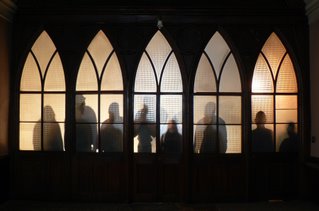However, classes are in session again this weekend, with the students attending Industrial Archeology this morning and Building Conservation this afternoon. Since the semester is winding down, our Friday evening session will mainly be social, and will be held at the Pumpkin House, the recently restored, National Register of Historic Places listed Federal home of Building Conservation program friend and historic Pottery District founder Carl Erickson. Three of the Building Conservation program's professors also live in the Pottery District, which is located at the southern edge of historic downtown Troy at the northern end of Little Italy.


The Pottery District is a great living laboratory for studying neighborhood revitalization, and, as in past years, we will hear about its founding and revitalization, an effort that has been going on since the mid-1990s, when Carl purchased and began restoring 180 Fourth Street with his father (before and after facade photos shown above). When the restoration work was well under way, he began holding pot luck dinners to show off his progress and working hard to attract new property owners and residents to occupy and rehabilitate surrounding buildings. Within a very short time, seven neighborhood houses were purchased and rehabilitated, with several new owners coming from outside Troy. Based on the neighborhood's history, the group christened themselves the Pottery District, and began advertising additional homes and reinforcing the neighborhood "brand" by developing t-shirts, sweat shirts, posters announcing work in progress, banners, and product labels for honey produced in neighborhood hives.
Tomorrow the students will once again travel by train to New York City, where they will meet at the offices of Building Conservation Associates and continue to the conservation labs at the Metropolitan Museum of Art.
Following exams two weeks from now, there will be no classes until Friday, January 12th.


